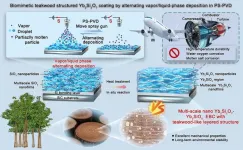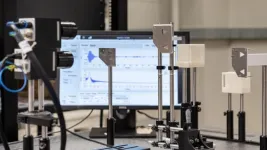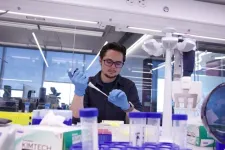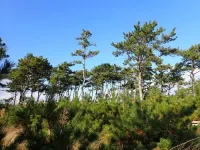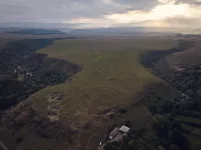The core message of the article is that researchers have developed an innovative technology in plasma spraying-physical vapor deposition known as alternating vapor/liquid phase deposition. By adjusting the arc current, researchers can finely control the evaporation and deposition of SiO2, and through a heat treatment process, achieve in-situ reactions that optimize the composition, structure, and nanoscale dimensions of the coating, creating an orderly arranged multi-layered teak-like biomimetic structure within it. They have conducted an in-depth analysis of the complex deposition mechanisms involved in this process. This new teak-like biomimetic structure coating is expected to significantly enhance its mechanical properties and corrosion resistance, providing an innovative coating protection strategy for high-temperature applications in the field of gas turbine engines.
The team published their work in Journal of Advanced Ceramics on December 19, 2024
“Biomimetic research on environmental barrier coatings is relatively rare, primarily because there are significant challenges in precisely controlling the composition and structure of the coatings during the high-temperature spraying process. We have chosen teak, known for its excellent mechanical properties and environmental durability, as the biomimetic subject. By employing the vapor-liquid phase interval deposition method and regulating parameters during the spraying process, such as arc current, we have achieved the evaporation and deposition of SiO2, thereby constructing a regularly arranged multi-layer structure within the coating. This unique deposition mechanism allows us to mimic the natural layered structure of teak, which is crucial for enhancing the mechanical properties and corrosion resistance of the coating.”said Dr. Guifang Han,the corresponding author of the paper, a professor in the School of Materials Science and Engineering at Shandong University.
“From a thermodynamic perspective, we have conducted an in-depth analysis of the deposition mechanism of volatilized SiO2 gas during the spraying process. We have ingeniously applied heat treatment technology to facilitate an in-situ reaction between the gas-phase deposited SiO2 and Yb2SiO5, which is produced from the decomposition of Yb2Si2O7 powder, to re-form Yb2Si2O7. This approach allows us to simultaneously regulate the composition, structure, and nanoscale dimensions of the coating, successfully achieving a functional structure that biomimics teak wood.”said Dr. Guifang Han
Despite the progress made, there is still much to explore in the field of biomimetic teak structure environmental barrier coatings. In this regard, Han also emphasized that the key to future research will be the systematic evaluation of the corrosion resistance and mechanical properties of these coatings, and comparing them with the findings in existing literature to verify their effectiveness in practical applications. The ultimate vision of the research is to commercialize these coating technologies, thereby enhancing the protection efficiency of high-temperature applications such as gas turbine engines.
Other contributors include Jungui Zhang, Xinxin Cao, Jingde Zhang from the School of Materials Science and Engineering at Shandong University in Jinan, China; Xiaofeng Zhang, Min Liu, Kesong Zhou from the Institute of New Materials at Guangdong Academy of Sciences in Guangzhou, China.
This work was supported by the National Natural Science Foundation of China (52322104, 52172067, 92160202), Natural Science Foundation of Guangdong Province (2021B1515020038), Guangdong Special Support Program (2019BT02C629), Guangdong Provincial Science and Technology Program (2023A0505010017), Science Center for Gas Turbine Project (P2023-C-IV-002-001).
About Author
Guifang Han, currently a professor and doctoral supervisor at the School of Materials Science and Engineering, Shandong University. She mainly engages in the design, preparation, and performance evaluation of ultra-high temperature ceramic materials and coatings for extreme environments, additive manufacturing of ceramic materials, and research on structure-function integrated materials. She has published over 90 SCI papers in journals such as Progress in Materials Science, Nature Communications, Journal of Advanced Ceramics, and Corrosion Science, and has been cited more than 2000 times; she has co-authored 2 academic monographs; presided over 7 scientific research projects including the National Natural Science Foundation of China; and serves as a member of the High-Temperature Branch of the Chinese Society for Corrosion, and a member of the Ceramic Matrix Composites Branch of the Chinese Composite Materials Society.
About Journal of Advanced Ceramics
Journal of Advanced Ceramics (JAC) is an international academic journal that presents the state-of-the-art results of theoretical and experimental studies on the processing, structure, and properties of advanced ceramics and ceramic-based composites. JAC is Fully Open Access, monthly published by Tsinghua University Press, and exclusively available via SciOpen. JAC’s 2023 IF is 18.6, ranking in Top 1 (1/31, Q1) among all journals in “Materials Science, Ceramics” category, and its 2023 CiteScore is 21.0 (top 5%) in Scopus database. ResearchGate homepage: https://www.researchgate.net/journal/Journal-of-Advanced-Ceramics-2227-8508
About SciOpen
SciOpen is an open access resource of scientific and technical content published by Tsinghua University Press and its publishing partners. SciOpen provides end-to-end services across manuscript submission, peer review, content hosting, analytics, identity management, and expert advice to ensure each journal’s development. By digitalizing the publishing process, SciOpen widens the reach, deepens the impact, and accelerates the exchange of ideas.
END
